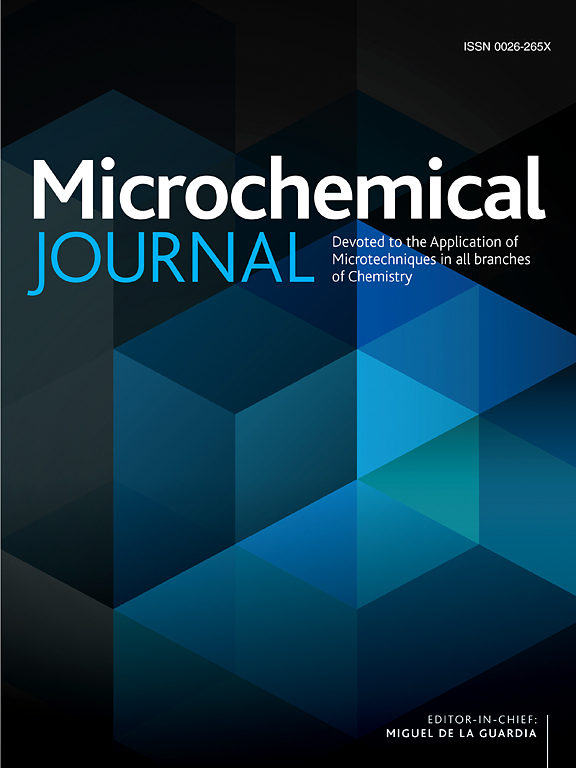Utilizing HPLC-DAD, multivariate analysis, molecular docking, and in vitro validation methods to investigate phenolic compounds with potential antidiabetic properties in Fraxinus mandshurica
IF 4.9
2区 化学
Q1 CHEMISTRY, ANALYTICAL
引用次数: 0
Abstract
This comprehensive study utilized response surface methodology (RSM) to optimize extraction conditions for total flavonoids and phenols from F. mandshurica. Optimal conditions for flavonoids were 75 % ethanol, 63 °C, and 84 min, yielding 14.98 ± 0.13 mg/g. For phenols, it was 70 % ethanol, 66 °C, and 87 min, resulting in 26.04 ± 0.22 mg/g. UPLC-Q-TOF-MS/MS identified 68 constituents in F. mandshurica, categorized into groups. HPLC-DAD established a method for quantitative analysis of 12 target compounds. Geographical distribution analysis highlighted the northeast region as the main production area. Fingerprinting of 30 samples and multivariate analysis identified five active compounds. Hierarchical cluster analysis (HCA) showed differences in active compounds based on origin. In vitro antidiabetic evaluation demonstrated α-glucosidase inhibitory effects. Molecular docking studies were conducted between 12 active compounds and the antidiabetic-related protein 8A27. Esculetin had the highest binding affinity. The study examined extraction methods, analyzed samples, and explored antidiabetic effects, providing data support and insights for F. mandshurica as a natural industrial product and for extracts and active compounds as antidiabetic sources.

利用 HPLC-DAD、多元分析、分子对接和体外验证方法研究梣树中具有潜在抗糖尿病特性的酚类化合物
这项综合研究利用响应面方法(RSM)优化了从F. mandshurica中提取总黄酮和酚的条件。黄酮类化合物的最佳萃取条件为 75%乙醇、63 °C、84 分钟,萃取率为 14.98 ± 0.13 mg/g。酚类物质的最佳提取条件为 70 %乙醇、66 °C 和 87 分钟,结果为 26.04 ± 0.22 mg/g。UPLC-Q-TOF-MS/MS 鉴别出了 F. mandshurica 中的 68 种成分,并进行了分类。HPLC-DAD 建立了 12 种目标化合物的定量分析方法。地理分布分析强调东北地区是主要产区。通过对 30 份样品进行指纹图谱分析和多元分析,确定了 5 种活性化合物。层次聚类分析(HCA)显示了基于产地的活性化合物差异。体外抗糖尿病评估显示了α-葡萄糖苷酶抑制作用。12 种活性化合物与抗糖尿病相关蛋白 8A27 进行了分子对接研究。埃斯库莱廷的结合亲和力最高。该研究考察了提取方法、分析了样品并探讨了抗糖尿病作用,为将曼殊兰作为一种天然工业产品以及将提取物和活性化合物作为抗糖尿病来源提供了数据支持和见解。
本文章由计算机程序翻译,如有差异,请以英文原文为准。
求助全文
约1分钟内获得全文
求助全文
来源期刊

Microchemical Journal
化学-分析化学
CiteScore
8.70
自引率
8.30%
发文量
1131
审稿时长
1.9 months
期刊介绍:
The Microchemical Journal is a peer reviewed journal devoted to all aspects and phases of analytical chemistry and chemical analysis. The Microchemical Journal publishes articles which are at the forefront of modern analytical chemistry and cover innovations in the techniques to the finest possible limits. This includes fundamental aspects, instrumentation, new developments, innovative and novel methods and applications including environmental and clinical field.
Traditional classical analytical methods such as spectrophotometry and titrimetry as well as established instrumentation methods such as flame and graphite furnace atomic absorption spectrometry, gas chromatography, and modified glassy or carbon electrode electrochemical methods will be considered, provided they show significant improvements and novelty compared to the established methods.
文献相关原料
| 公司名称 | 产品信息 | 采购帮参考价格 |
|---|---|---|
| 上海源叶 |
Esculin
|
|
| 上海源叶 |
caffeic acid
|
 求助内容:
求助内容: 应助结果提醒方式:
应助结果提醒方式:


